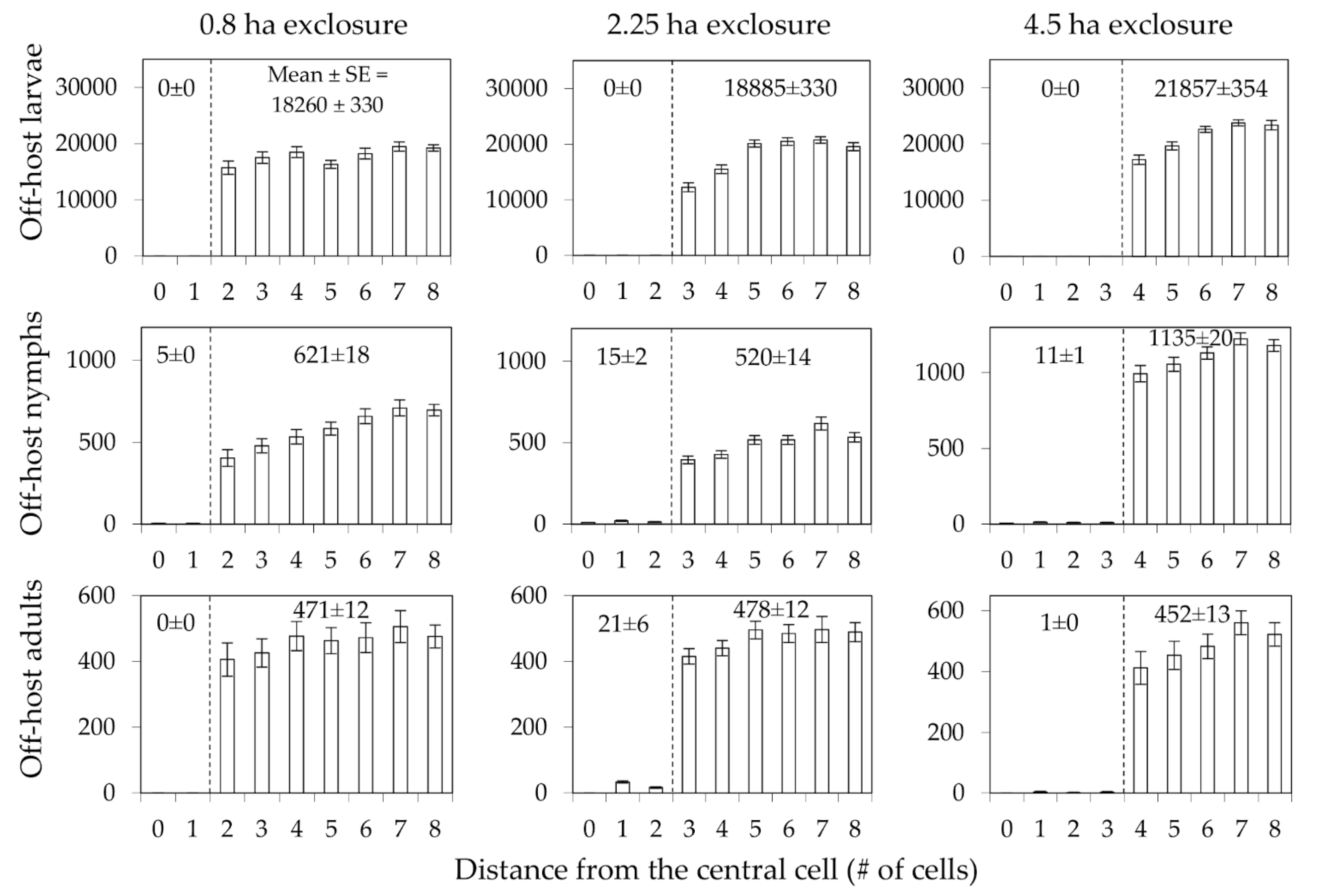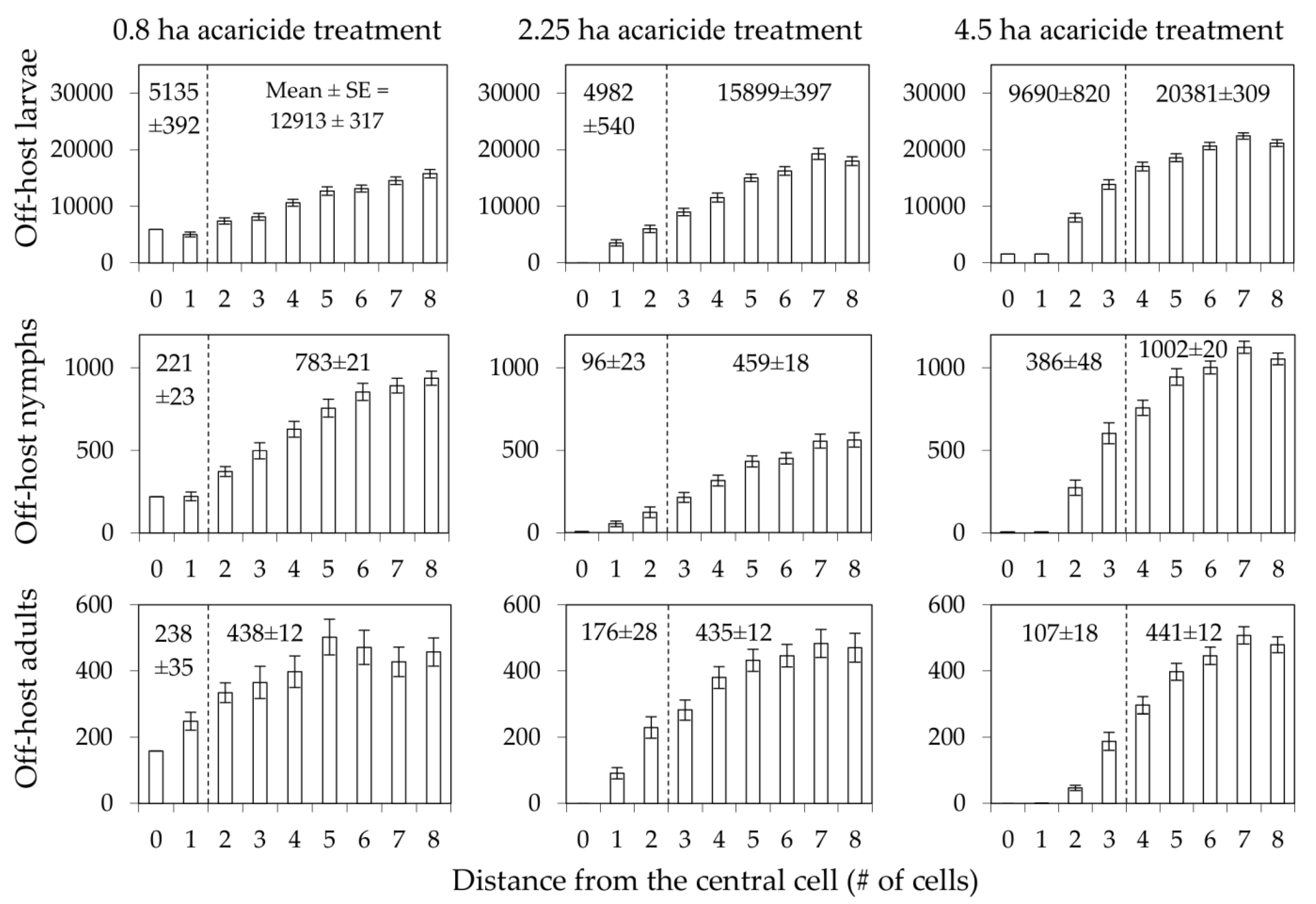Modeling Effects of Vertebrate Host Exclosures and Host-Targeted Acaricides on Lone Star Tick (Amblyomma americanum, L.) Infestations
Abstract
1. Introduction
2. Materials and Methods
3. Results
4. Discussion
Author Contributions
Funding
Institutional Review Board Statement
Informed Consent Statement
Data Availability Statement
Acknowledgments
Conflicts of Interest
References
- Childs, J.E.; Paddock, C.D. The ascendancy of Amblyomma americanum as a vector of pathogens affecting humans in the United States. Annu. Rev. Entomol. 2003, 48, 307–337. [Google Scholar] [CrossRef] [PubMed]
- Bloemer, S.R.; Snoddy, E.L.; Cooney, J.C.; Fairbanks, K. Influence of deer exclusion on populations of lone star ticks and American dog ticks (Acari: Ixodidae). J. Econ. Entomol. 1986, 79, 679–683. [Google Scholar] [CrossRef]
- Perkins, S.E.; Cattadori, I.M.; Tagliapietra, V.; Rizzoli, A.P.; Hudson, P.J. Localized deer absence leads to tick amplification. Ecology 2006, 87, 1981–1986. [Google Scholar] [CrossRef]
- Cooney, J.C.; Burgdorfer, W. Zoonotic potential (Rocky Mountain spotted fever and tularemia) in the Tennessee Valley region: I. Ecologic studies of ticks infesting mammals in land between the lakes. Am. J. Trop. Med. Hyg. 1974, 23, 99–108. [Google Scholar] [CrossRef] [PubMed]
- Bishop, A.; Borski, J.; Wang, H.-H.; Donaldson, T.G.; Michalk, A.; Montgomery, A.; Heldman, S.; Mogg, M.; Derouen, Z.; Grant, W.E. Increasing incidence of spotted fever group rickettsioses in the United States, 2010–2018. Vector-Borne Zoonotic Dis. 2022, 22, 491–497. [Google Scholar] [CrossRef]
- Parker, R.R.; Kohls, G.M. American Q fever: The occurrence of Rickettsia diaporica in Amblyomma ammerucanum in eastern Texas. Public Health Rep. 1943, 58, 1510–1511. [Google Scholar] [CrossRef]
- Schulze, T.A.; Bowen, G.S.; Bosler, E.M.; Lakat, M.F.; Parkin, W.E.; Altman, R.; Ormiston, B.G.; Shisler, J.K. Amblyomma americanum: A potential vector of Lyme disease in New Jersey. Science 1984, 224, 601–603. [Google Scholar] [CrossRef]
- James, A.M.; Liveris, D.; Wormser, G.P.; Schwartz, I.; Montecalvo, M.A.; Johnson, B.J.B. Borrelia lonestari infection after a bite by an Amblyomma americanum tick. J. Infect. Dis. 2001, 183, 1810–1814. [Google Scholar] [CrossRef]
- Loftis, A.D.; Levin, M.L.; Spurlock, J.P. Two USA Ehrlichia spp. cause febrile illness in goats. Vet. Microbiol. 2008, 130, 398–402. [Google Scholar] [CrossRef]
- Mogg, M.; Wang, H.-H.; Baker, A.; Derouen, Z.; Borski, J.; Grant, W.E. Increased incidence of Ehrlichia chaffeensis infections in the United States, 2012 through 2016. Vector-Borne Zoonotic Dis. 2020, 20, 547–550. [Google Scholar] [CrossRef]
- Sonenshine, D.E.; Kocan, K.M.; de la Fuente, J. Tick control: Further thoughts on a research agenda. Trends Parasitol. 2006, 22, 550–551. [Google Scholar] [CrossRef] [PubMed]
- Pound, J.M.; Miller, J.A.; George, J.E.; Fish, D.; Carroll, J.F.; Schulze, T.L.; Daniels, T.J.; Falco, R.C.; StaffordIII, K.C.; Mather, T.N. The United States Department of Agriculture’s Northeast Area-Wide Tick Control Project: Summary and Conclusions. Vector-Borne Zoonotic Dis. 2009, 9, 439–448. [Google Scholar] [CrossRef]
- Piesman, J. Strategies for reducing the risk of Lyme borreliosis in North America. Int. J. Med. Microbiol. 2006, 296, 17–22. [Google Scholar] [CrossRef] [PubMed]
- Stafford, K.C. Reduced abundance of Ixodes scapularis (Acari: Ixodidae) and the tick parasitoid Ixodiphagus hookeri (Hymenoptera: Encyrtidae) with reduction of white-tailed deer. J. Med. Entomol. 2003, 40, 642–652. [Google Scholar] [CrossRef] [PubMed]
- Rand, P.W.; Lubelczyk, C.; Holman, M.S.; Lacombe, E.H.; Smith, R.P. Abundance of Ixodes scapularis (Acari: Ixodidae) after the complete removal of deer from an isolated offshore island, endemic for Lyme disease. J. Med. Entomol. 2004, 41, 779–784. [Google Scholar] [CrossRef]
- Wilson, M.L. Distribution and abundance of Ixodes scapularis (Acari: Ixodidae) in North America: Ecological processes and spatial analysis. J. Med. Entomol. 1998, 35, 446–457. [Google Scholar] [CrossRef]
- Stafford, K.C. Reduced abundance of Ixodes scapularis (Acari: Ixodidae) with exclusion of deer by electric fencing. J. Med. Entomol. 1993, 30, 987–996. [Google Scholar] [CrossRef]
- Ginsberg, H.S.; Zhioua, E. Influence of deer abundance on the abundance of questing adult Ixodes scapularis (Acari: Ixodidae). J. Med. Entomol. 1999, 36, 376–381. [Google Scholar] [CrossRef]
- Ginsberg, H.S.; Butler, M.; Zhioua, E. Effect of deer exclusion by fencing on abundance of Amblyomma americanum (Acari: Ixodidae) on Fire Island, New York, USA. J. Vector Ecol. 2002, 27, 215–221. [Google Scholar]
- Pound, J.M.; Miller, J.A.; George, J.E.; Lemeilleur, C.A. The 4-Poster passive topical treatment device to apply acaricide for controlling ticks (Acari: Ixodidae) feeding on white-tailed deer. J. Med. Entomol. 2000, 37, 588–594. [Google Scholar] [CrossRef]
- White, A.; Gaff, H. Review: Application of tick control technologies for blacklegged, lone star, and american dog ticks. J. Integr. Pest Manag. 2018, 9, 12. [Google Scholar] [CrossRef]
- Hüe, T.; Berger, A.; Wang, H.-H.; Grant, W.E.; Teel, P.D.; de León, A.A.P. Integrated control of the cattle tick, Rhipicephalus australis (Acari: Ixodidae), in New Caledonia through the pasture and cattle management method. Parasitol. Res. 2021, 120, 2749–2758. [Google Scholar] [CrossRef] [PubMed]
- Hüe, T.; Fontfreyde, C.; Wang, H.-H.; Grant, W.E.; Teel, P.D.; de León, A.A.P. Optimizing long-acting acaricide use for integrated tick management of Rhipicephalus australis-infesting cattle in New Caledonia. Trop. Anim. Health Prod. 2021, 53, 384. [Google Scholar] [CrossRef] [PubMed]
- Gaff, H.; Gross, L. Modeling tick-borne disease: A metapopulation model. Bull. Math. Biol. 2007, 69, 265–288. [Google Scholar] [CrossRef]
- Wang, H.H.; Corson, M.S.; Grant, W.E.; Teel, P.D. Quantitative models of Rhipicephalus (Boophilus) ticks: Historical review and synthesis. Ecosphere 2017, 8, e01942. [Google Scholar] [CrossRef]
- Schmidt, K.A.; Ostfeld, R.S. Biodiversity and the dilution effect in disease ecology. Ecology 2001, 82, 609–619. [Google Scholar] [CrossRef]
- Wang, H.-H.; Teel, P.D.; Grant, W.E.; Schuster, G.; de León, A.A.P. Simulated interactions of white-tailed deer (Odocoileus virginianus), climate variation and habitat heterogeneity on southern cattle tick (Rhipicephalus (Boophilus) microplus) eradication methods in south Texas, USA. Ecol. Model. 2016, 342, 82–96. [Google Scholar] [CrossRef]
- Wang, H.-H.; Teel, P.D.; Grant, W.E.; Soltero, F.; Urdaz, J.; Ramírez, A.E.P.; Miller, R.J.; de León, A.A.P. Simulation tools for assessment of tick suppression treatments of Rhipicephalus (Boophilus) microplus on non-lactating dairy cattle in Puerto Rico. Parasites Vectors 2019, 12, 185. [Google Scholar] [CrossRef]
- Wang, H.-H.; Grant, W.E.; Teel, P.D.; Lohmeyer, K.H.; de León, A.P. Enhanced biosurveillance of high-consequence invasive pests: Southern cattle fever ticks, Rhipicephalus (Boophilus) microplus, on livestock and wildlife. Parasites Vectors 2020, 13, 487. [Google Scholar] [CrossRef]
- Agudelo, M.S.; Grant, W.E.; Wang, H.H. Effects of white-tailed deer habitat use preferences on southern cattle fever tick eradication: Simulating impact on “pasture vacation” strategies. Parasites Vectors 2021, 14, 102. [Google Scholar] [CrossRef]
- Wang, H.-H.; Grant, W.E.; Teel, P.D.; Lohmeyer, K.H.; de León, A.A.P. Simulated dynamics of southern cattle fever ticks (Rhipicephalus (Boophilus) microplus) in south Texas, USA: Investigating potential wildlife-mediated impacts on eradication efforts. Parasites Vectors 2021, 14, 231. [Google Scholar] [CrossRef] [PubMed]
- Clymer, B.C.; Howell, D.; Hair, J.A. Animal hosts of economically important ticks (Acarina) in east-central Oklahoma. Ann. Entomol. Soc. Am. 1970, 63, 612–613. [Google Scholar] [CrossRef]
- Wang, H.-H.; Grant, W.E.; Teel, P.D. Simulation of climate-host-parasite-landscape interactions: A spatially explicit model for ticks (Acari: Ixodidae). Ecol. Model. 2012, 243, 42–62. [Google Scholar] [CrossRef]
- Wang, H.H.; Grant, W.; Teel, P.; Hamer, S. Simulation of climate-tick-host-landscape interactions: Effects of shifts in the seasonality of host population fluctuations on tick densities. J. Vector Ecol. 2015, 40, 247–255. [Google Scholar] [CrossRef]
- Wang, H.-H.; Grant, W.; Teel, P.; Hamer, S. Tick-borne infectious agents in nature: Simulated effects of changes in host density on spatial-temporal prevalence of infected ticks. Ecol. Model. 2016, 323, 77–86. [Google Scholar] [CrossRef]
- Goddard, J.; Varela-Stokes, A.S. Role of the lone star tick, Amblyomma americanum (L.), in human and animal diseases. Vet. Parasitol. 2009, 160, 1–12. [Google Scholar] [CrossRef]
- Schmidly, D.J. Texas Mammals East of the Balcones Fault Zone; Texas A&M University: College Station, TX, USA, 1983; p. 400. [Google Scholar]
- Piesman, J.; Eisen, L. Prevention of tick-borne diseases. Annu. Rev. Entomol. 2008, 53, 323–343. [Google Scholar] [CrossRef] [PubMed]
- Drummond, R.O. Seasonal activity of ticks (Acarina: Metastigmata) on cattle in southwestern Texas. Ann. Entomol. Soc. Am. 1967, 60, 439–447. [Google Scholar] [CrossRef]





Publisher’s Note: MDPI stays neutral with regard to jurisdictional claims in published maps and institutional affiliations. |
© 2022 by the authors. Licensee MDPI, Basel, Switzerland. This article is an open access article distributed under the terms and conditions of the Creative Commons Attribution (CC BY) license (https://creativecommons.org/licenses/by/4.0/).
Share and Cite
Wang, H.-H.; Grant, W.E.; Donaldson, T.G.; Teel, P.D. Modeling Effects of Vertebrate Host Exclosures and Host-Targeted Acaricides on Lone Star Tick (Amblyomma americanum, L.) Infestations. Pathogens 2022, 11, 1412. https://doi.org/10.3390/pathogens11121412
Wang H-H, Grant WE, Donaldson TG, Teel PD. Modeling Effects of Vertebrate Host Exclosures and Host-Targeted Acaricides on Lone Star Tick (Amblyomma americanum, L.) Infestations. Pathogens. 2022; 11(12):1412. https://doi.org/10.3390/pathogens11121412
Chicago/Turabian StyleWang, Hsiao-Hsuan, William E. Grant, Taylor G. Donaldson, and Pete D. Teel. 2022. "Modeling Effects of Vertebrate Host Exclosures and Host-Targeted Acaricides on Lone Star Tick (Amblyomma americanum, L.) Infestations" Pathogens 11, no. 12: 1412. https://doi.org/10.3390/pathogens11121412
APA StyleWang, H.-H., Grant, W. E., Donaldson, T. G., & Teel, P. D. (2022). Modeling Effects of Vertebrate Host Exclosures and Host-Targeted Acaricides on Lone Star Tick (Amblyomma americanum, L.) Infestations. Pathogens, 11(12), 1412. https://doi.org/10.3390/pathogens11121412





